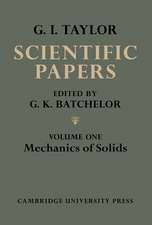Biological Motion: Proceedings of a Workshop held in Königswinter, Germany, March 16–19, 1989: Lecture Notes in Biomathematics, cartea 89
Editat de Wolfgang Alt, Gerhard Hoffmannen Limba Engleză Paperback – 12 feb 1991
Din seria Lecture Notes in Biomathematics
-
 Preț: 378.54 lei
Preț: 378.54 lei -
 Preț: 380.45 lei
Preț: 380.45 lei -
 Preț: 413.37 lei
Preț: 413.37 lei -
 Preț: 390.63 lei
Preț: 390.63 lei -
 Preț: 396.24 lei
Preț: 396.24 lei -
 Preț: 387.38 lei
Preț: 387.38 lei -
 Preț: 385.08 lei
Preț: 385.08 lei - 5%
 Preț: 366.56 lei
Preț: 366.56 lei -
 Preț: 384.70 lei
Preț: 384.70 lei -
 Preț: 388.13 lei
Preț: 388.13 lei -
 Preț: 394.29 lei
Preț: 394.29 lei - 5%
 Preț: 389.93 lei
Preț: 389.93 lei - 5%
 Preț: 370.74 lei
Preț: 370.74 lei -
 Preț: 384.86 lei
Preț: 384.86 lei -
 Preț: 387.96 lei
Preț: 387.96 lei -
 Preț: 404.29 lei
Preț: 404.29 lei -
 Preț: 391.61 lei
Preț: 391.61 lei -
 Preț: 384.48 lei
Preț: 384.48 lei -
 Preț: 384.48 lei
Preț: 384.48 lei -
 Preț: 383.71 lei
Preț: 383.71 lei -
 Preț: 379.68 lei
Preț: 379.68 lei -
 Preț: 384.09 lei
Preț: 384.09 lei -
 Preț: 405.66 lei
Preț: 405.66 lei -
 Preț: 379.48 lei
Preț: 379.48 lei -
 Preț: 400.65 lei
Preț: 400.65 lei -
 Preț: 385.25 lei
Preț: 385.25 lei -
 Preț: 390.25 lei
Preț: 390.25 lei -
 Preț: 395.47 lei
Preț: 395.47 lei -
 Preț: 378.71 lei
Preț: 378.71 lei -
 Preț: 382.95 lei
Preț: 382.95 lei - 15%
 Preț: 578.01 lei
Preț: 578.01 lei -
 Preț: 380.84 lei
Preț: 380.84 lei -
 Preț: 405.66 lei
Preț: 405.66 lei -
 Preț: 399.12 lei
Preț: 399.12 lei -
 Preț: 410.66 lei
Preț: 410.66 lei -
 Preț: 385.62 lei
Preț: 385.62 lei - 5%
 Preț: 371.10 lei
Preț: 371.10 lei -
 Preț: 378.71 lei
Preț: 378.71 lei -
 Preț: 386.99 lei
Preț: 386.99 lei -
 Preț: 401.61 lei
Preț: 401.61 lei -
 Preț: 350.30 lei
Preț: 350.30 lei -
 Preț: 383.33 lei
Preț: 383.33 lei -
 Preț: 408.54 lei
Preț: 408.54 lei -
 Preț: 398.53 lei
Preț: 398.53 lei -
 Preț: 399.67 lei
Preț: 399.67 lei -
 Preț: 391.79 lei
Preț: 391.79 lei -
 Preț: 384.86 lei
Preț: 384.86 lei -
 Preț: 401.61 lei
Preț: 401.61 lei -
 Preț: 392.60 lei
Preț: 392.60 lei -
 Preț: 406.05 lei
Preț: 406.05 lei
Preț: 411.64 lei
Nou
Puncte Express: 617
Preț estimativ în valută:
78.77€ • 84.23$ • 65.67£
78.77€ • 84.23$ • 65.67£
Carte tipărită la comandă
Livrare economică 17 aprilie-01 mai
Preluare comenzi: 021 569.72.76
Specificații
ISBN-13: 9783540535201
ISBN-10: 3540535209
Pagini: 620
Ilustrații: X, 607 p. 78 illus.
Dimensiuni: 170 x 244 x 33 mm
Greutate: 0.97 kg
Ediția:1990
Editura: Springer Berlin, Heidelberg
Colecția Springer
Seria Lecture Notes in Biomathematics
Locul publicării:Berlin, Heidelberg, Germany
ISBN-10: 3540535209
Pagini: 620
Ilustrații: X, 607 p. 78 illus.
Dimensiuni: 170 x 244 x 33 mm
Greutate: 0.97 kg
Ediția:1990
Editura: Springer Berlin, Heidelberg
Colecția Springer
Seria Lecture Notes in Biomathematics
Locul publicării:Berlin, Heidelberg, Germany
Public țintă
ResearchCuprins
Motion of Cell or Body Parts.- Quantifying Cellular Shape Using Moment Invariants.- Analysis of Leucocyte Shape Changes.- Images of Cells Changing Shape: Pseudopods, Skeletons and Motile Behaviour.- Continuity of Movement and Preservation of Architecture during Cell Locomotion.- Periodic Contraction Waves in Cytoplasmic Extracts.- Motion Analysis of Intracellular Objects: Trajectories with and without Visible Tracks.- Centrin-Mediated Cell Motility in Eukariotic Cells.- Descriptive and Mechanistic Models of Flagellar Motility.- Discrete Nature of Flagellar Bending Detected by Digital Image Analysis.- An Approach to Quantitative Analysis and Modelling of Three-Dimensional Ciliary Motion.- Bioelectric Control of the Ciliary Cycle.- Ca-Mg Control of Ciliary Motion: A Quantitative Model Study.- Modelling the Control of Walking in Insects.- Coordination of Contralateral Legs in Walking Crayfish.- Flight Manoeuvres of Locusts.- How a Fish’s Brain May Move a Fish’s Body.- Locomotion of Single Organisms.- Correlation Analysis of Two-Dimensional Locomotion Paths.- Paths of Carabid Beetles Walking in the Absence of Orienting Stimuli and the Time Structure of their Motor Output.- Microzooplankton Feeding Behavior and the Levy Walk.- Adaptation and Orientation in Animals’ Movements: Random Walk, Kinesis, Taxis and Path-Integration.- The Site Independent Information that an Isopod Uses for Homing.- A Simulation Model of Foraging Excursions in Intertidal Chitons.- How to Describe the Search of a Predator for Patchily Distributed Prey?.- Tracking of Flagellates by Image Analysis.- Helical Orientation — A Novel Mechanism for the Orientation of Microorganisms.- Motile Behaviour and Determination of the Magnetic Moment of Magnetic Bacteria in Rotating Magnetic Fields.-Chemokinesis, Chemotaxis and Galvanotaxis Dose-Response Curves and Signal Chains.- Models of Chemical Gradient Sensing by Cells.- Endothelial Cell Chemotaxis in Angiogenesis.- A Model for Trail Following in Ants: Individual and Collective Behaviour.- Definition and Measurement of Cell Migration Coefficients.- Signals for Chemotaxis and Chemokinesis in Cells of Dictyostelium Discoideum.- Distinction Between Kinesis and Taxis in Terms of System Theory.- Collective Motion.- Functional Self-Organisation Illustrated by Inter-Nest Traffic in Ants: The Case of the Argentine Ant.- Simulations of the Gliding Behavior and Aggregation of Myxobacteria.- A One Dimensional Model for the Swarming Behavior of Myxobacteria.- From Cell to Tissue; Contact Mediated Orientation Selection in a Population.- The Movement of Fish Schools: A Simulation Model.

















